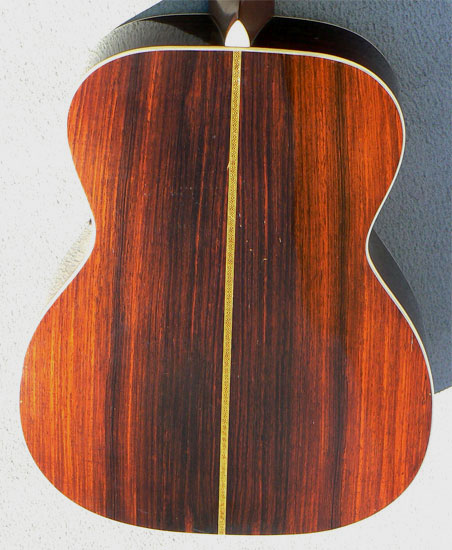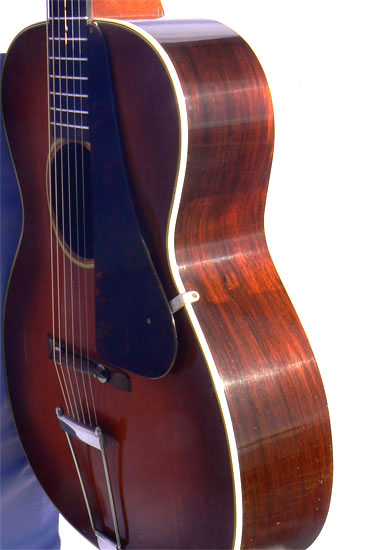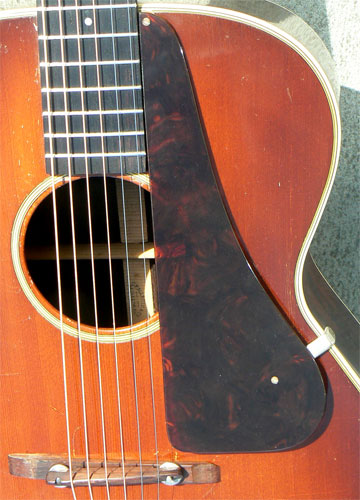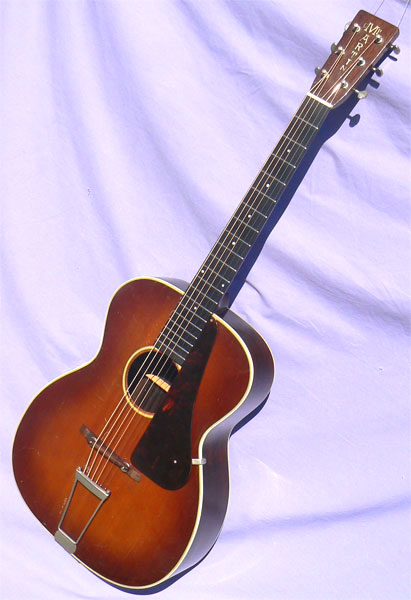
Home / Instruments /Accessories / Ordering / Tips / Friends
archtop.com
1931 Martin C-2 Archtop, Brazilian Rosewood 
Status: For pricing and hold status for this instrument, please check our Instruments page here. If this instrument does not appear on the Instruments page it has been sold, and is no longer available. Photos and descriptions of Previously Sold instruments may by found here. To be notified of examples of this or any other model in the future, please contact [email protected]
Serial #: 49020, stamped on neck block
Body size at lower bout: 15" Scale length: 25 1/2" Nut Width: 1 3/4" Body depth: 3 3/8"- 4 1/8" at endpin Neck Depth: .80/.96, 1st/10th frets
Materials: Handcarved bookmatched solid Adirondack spruce top; solid bookmatched Brazilian rosewood back and sides; solid one piece mahogany neck; solid ebony fingerboard; mother of pearl peghead logo and fingerboard inlay; bound fingerboard, triple bound body.
Hardware: Original hardware includes nickel Grover Sta-Tite open back tuners and celluloid tortoise pickguard. Period nickel trapeze tailpiece and adjustable compensated rosewood bridge.
Notes: One of the more frequent queries hereabouts goes like this: "Where can I find a guitar that has archtop projection, with the bass response and sustain of a good flat top?" If this is you, look no further.
Prized for its superlative tone, incomparable appearance, and scarcity, Brazilian rosewood has been the gold standard for acoustic guitar builders for centuries. So where are all the Brazilian archtops? With only the rarest of exceptions, Brazilian rosewood has never been employed by any of the major manufacturers, or independent luthiers, of archtop guitars. Several reasons suggest themselves. The first is cost: a carved archtop requires tonewood up to a full inch in thickness, to properly form the curve and recurve of the back alone.
By contrast, a slab of Brazilian of this dimension might provide a half dozen or more back plates for flat tops or classical guitars. Second is workability: the hard, dense and oily consistency of rosewood could put a mighty strain on rough-carving machines, and give cramps to the poor souls completing the graduation with hand planes. And last but not least: simple tradition. As fretted cousins of the venerable viol family, archtops have since their inception been built customarily with maple bodies, the more highly figured the better.
Enter C.F. Martin and Co. Founded in 1833, the firm had over the course of a century become the pre-eminent producer of flat top guitars. But nearing its centenary, Martin realized that its hopefully designated Orchestra Model instruments were being used everywhere else but on the bandstand. By mid 1931, company designers responded with two dramatic innovations: the first Martin-branded dreadnoughts, and the new models C-1 and C-2: Martin's first archtop guitars.
Like Gibson's venerable L-4 model, the C-2 was originally built with a round soundhole, in a carved solid Adirondack spruce soundboard. Martin's most popular and longest running archtop model, the C-2 was offered in an f-hole version as well the following year, which continued in production for another decade. Though regarded today by most players as acoustically superior, the round hole C-2 was produced for only three years until it was retired after 1933. This remarkable instrument is one of only 104 round hole C-2 archtops from the first model year. Priced at a whopping $200 in the depths of the Great Depression, Martin's top-line C-3 archtop was the most expensive instrument in the catalog, $20 more than the ornate OM-45, with the C-2 at $120 not far behind.
The gently arched back and sides are constructed of exceptionally attractive bookmatched quartersawn Brazilian rosewood, of a hue and grain structure virtually unobtainable today. The 15" body is virtually identical in shape to Martin's legendary OM models, tapering in depth from a little over 3" at the heel to over 4" at the endpin. A particularly versatile instrument, the C-2's carved Adirondack soundboard lends projection and clarity far in excess of comparably sized flat tops, while its X-bracing produces a warmth and sustain unusual in conventional archtop guitars. With it's generous 1 3/4" nut, the C-2 is particularly congenial to fingerstyle play, yet responds like thunder to a good stiff pick. At a phenomenal 4lb. 3 oz., the guitar has to be of the lightest production archtops ever made. Well crafted and well balanced, this featherweight construction is another clue to its distinctive power and resonance.
This remarkable instrument has been preserved in wonderful condition, with all original sunburst finish, and original nickel Grover Stat-Tite open back tuners. The adjustable rosewood bridge is of period vintage, as well as the trapeze tailpiece, which was added along with a ivoroid plug to the original endpin hole. The vintage style fretwork is freshly installed, on a dark ebony fingerboard which appears to have been replaced at some point. As befits its premium status, the peghead is graced with a 45 style vertical Martin logo, and the back stripe set with 28 style zig-zag purfling. The guitar is notably free of pick, buckle, thumb or fingerboard wear, and apart from some scattered finish nicks around the tailpiece and bridge, the instrument shows scant playwear for its considerable vintage. Action is smooth and low with a fresh high precision setup, over a comfy light V profile neck.
The voice is truly remarkable, with open resonant bass, clear bright trebles, and extended sustain: a wonderfully adaptable instrument for a wide variety of styles. Of the few Martin archtops made, fewer still survive, especially the Brazilian models, as many have been converted to flat tops over the decades. This handsome and versatile guitar is a rare opportunity: one only, call now.
Setup: Bridge height adjusted; bridge compensation set; string slots at nut and bridge inspected and recut as necessary; bridge wheels and tuners lubricated; fingerboard and bridge oiled; body and neck cleaned and hand polished.This instrument is strung with medium gauge bronze strings (.013-.056). The guitar will accommodate lighter or heavier gauge strings, according to preference. String action is set at 5/64" to 4/64" at the 12th fret, with moderate relief for acoustic playing with medium strings. The action may be lowered or raised to your requirements with the adjustable bridge.
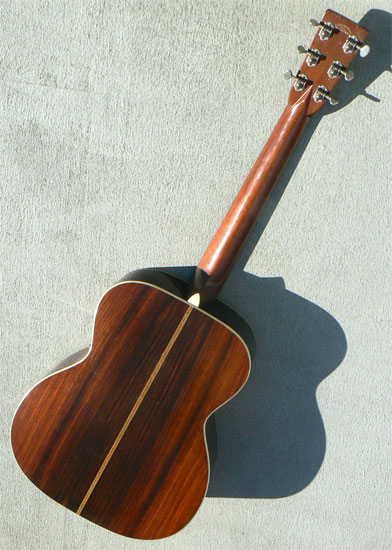 Case: Recent Martin deluxe black arched plush lined hardshell case.
Case: Recent Martin deluxe black arched plush lined hardshell case.